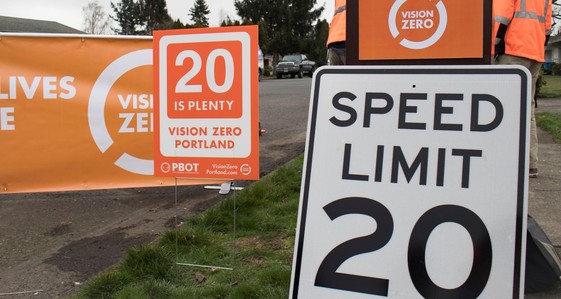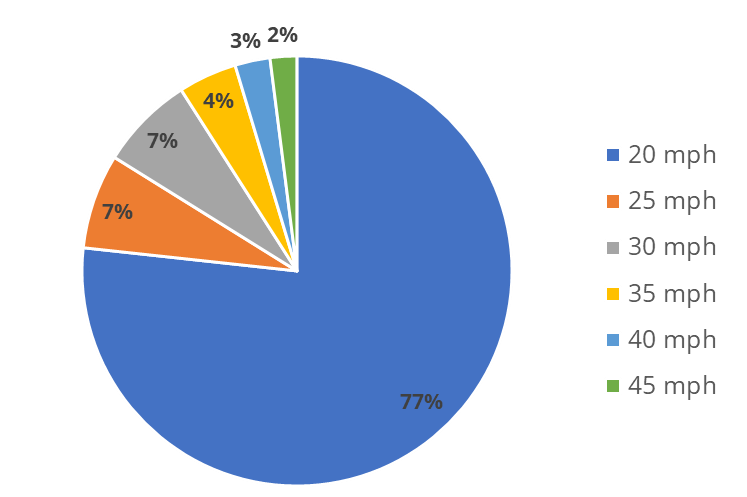 The Portland Bureau of Transportation’s residential speed limit reduction from 25 to 20 mph, completed in 2019, has likely reduced driving speeds by small but significant amounts, according to an analysis conducted in partnership with Portland State University researchers.
Before and after data show that lower percentages of people drove above 25, 30, and 35 mph on streets subject to the speed limit reduction (see Table 1). These reductions in driving speed were found across a majority of the 58 locations analyzed in the study (see map below).
| Table 1. Percent of vehicles exceeding 25, 30 and 35 mph before and after speed limit reduction from 25 to 20 mph |
| Period |
Greater than 25 mph |
Greater than 30 mph |
Greater than 35 mph |
| Before |
24.13% |
6.49% |
1.11% |
| After |
23.60% |
4.83% |
0.59% |
A statistical analysis of the data reveals sharp decreases in the probability of people driving faster than 25, 30, and 35 mph following the speed limit change (see Table 2).
| Table 2. Estimated change in odds of observing vehicles exceeding 25, 30, and 35 mph after speed limit reduction |
| |
Greater than 25 mph |
Greater than 30 mph |
Greater than 35 mph |
| Estimated change in odds |
-15.9% |
-33.6% |
-49.6% |
Portland State University researchers write that the reductions in speeds are "noteworthy" due to "the link to crash severity for vulnerable users." Studies have found that even small reductions in speed can have large safety benefits, especially for pedestrians.
Other findings from Portland's study: Speeds tended to be higher on Wednesday, Thursday, and Friday relative to other days, on wider streets, and on streets with better pavement condition.
About three-fourths of Portland streets have 20 mph speed limits (see chart below). A citywide map of current speed limits is available here.
 Orange dots show the 58 locations where PBOT collected before and after speed data.
High-end speeds are a key metric for safety
Average driving speeds were essentially unchanged after PBOT reduced the speed limit, measuring about 22 mph across the 58 locations where data was collected.
These seemingly contradictory findings—reduced percentages of high speeds, but nearly identical average speeds—are due to the relatively small number of high speeds that were recorded.
Given the powerful negative effect of higher speeds on safety, the National Association of City Transportation Officials recommends that speed limit evaluations heavily weigh "high-end" speeds, or "the number or percent of drivers exceeding specific, high-risk speed thresholds," to accurately assess the safety impacts of speed limit changes.
The results from Portland's study are similar to those from a growing body of research suggesting that speed limits meaningfully impact driving speeds and safety in urban areas. Seattle has experienced reduced speeds and crashes following speed limit changes. Published studies from Boston, Bristol (UK), and Toronto (Canada) credit speed limit reductions with beneficial traffic safety impacts.
 Miles of street by speed limit in Portland. Most of the approximately 3,000 miles of street in Portland have a 20 mph speed limit. (Graph excludes freeways and the less than 1% of streets that are 15 or 50 mph.)
Analysis details and limitations
Portland’s findings are based on an analysis of 214,220 data points collected at 58 locations before and after the 20 mph speed limit took effect on April 1, 2018.
Crash data was not included in Portland’s analysis due to lag times in statewide crash reporting. Complete crash data is currently available only through 2018.
Portland’s analysis cannot conclude that speed limits caused a change in travel driving speeds. Doing so would require observing the same travelers in identical conditions before and after a speed limit change, a practical impossibility. Given these limitations, Portland’s analysis can identify only correlations between speed limits and driving speeds. Factors other than a speed limit reduction that may impact driving speeds include driver characteristics, weather conditions, and vehicle types. Portland's analysis also did not include a control group, which can help to eliminate confounding factors.
###
For a limited time, we are offering free yard signs with contact-free delivery to your door.
Choose from several safety messages in English or Spanish and one of our volunteers will get the sign to your home.
There are a limited number of signs remaining, order yours today!
We are offering these signs because community members have indicated there has been more speeding and dangerous driving behaviors during the COVID-19 pandemic. We are distributing the signs to encourage safe behavior at a time when more people are out walking and rolling for exercise, errands, and self-care.
It's important to me that people drive slowly through our neighborhood because I have a young daughter and I want to feel comfortable walking around our neighborhood together."
-Parent, South Burlingame Neighborhood
|